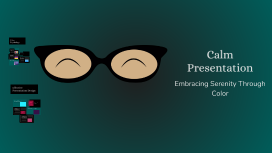Calm presentation
Transcript: Substance Use Amongst Youth Awareness and Education Damaris Fuentes, RN Introduction Hello, my name is Damaris Registered Nurse with a strong interest in mental health and working with vulnerable populations. 3 Things to be Mindful of RESPECT Not talking while others are speaking, avoiding non judgmental comments and statements PARTICIPATION If triggered feel free to quietly step out and return if you feel okay. Save questions for when discussion opens up. CONFIDENTIALITY What's shared in this room, stays in this room. Poll Results Poll Results https://freeonlinesurveys.com/r/TgJlplUr Substances Neurotransmitters Released from a neuron or a nerve cell a neurotransmitters floats across the synaptic space and attaches to the receptor of the second neuron. Once its message is carried to the receptor cell the neurotransmitter then floats back into the synaptic space of origin and is reuptaken for later use Types of Nuero- transmitters Gaba: Main inhibitory neurotransmitter responsible for relaxation Dopamine: Important for important for motivation, incentive and energy, satisfaction Serotonin: Important for mood stability, self confidence, pain tolerance and sleep Epinephrin/Adrenalin: Stimulates the body and causes your blood pressure and heart rate to increase, and makes you breathe harder Endorphins: physical and emotional pain, relief pleasure, good feelings, sense of wellbeing Drugs Drugs Tobacco/ E-cigarrettes Vapes/ Nicotene Tobacco is a product made from leaves that can be smoked, chewed, or sniffed. (Cigarrettes, Snuff, Chew). It contains nicotene which people become highly addicted to. Vapes or E-Cigarettes are battery operated devices that vaporize the fluid in the cartridge by heating the device Cannabis Cannabis a product that comes from the cannbis plant that can be consumed in many forms eaten or smoked mainly. THC (tetrehydrocannibinol) is the chemical that gives a psychoactive effect. Cocaine Derived from the coca plant leaves and made into powder form cocaine hydrochloride which is snorted or injected commonly. It can also be made into "rock" form which is crack cocaine which is often smoked. It is a CNS stimulant that stimulates feelings of euphoria and alertness. Cocaine Fentanyl Fentanyl This is an opioid used to manage pain often in hospital settings. It also depresses the CNS system. Now we are receiving large amounts on the streets that is unpredicatble and reliable laced into other substances. Can be small chalky pebbles in various colours. Can be smoked, injected or consumed orally. Methamphetamine Stimulant on the streets that often looks like crystal shards that stimulates CNS for similar effects like cocaine. Alertness, motivation and euphoria. Meth Mushrooms (Psilocybin) Mushrooms Derived from fungi. They are usually consumed orally as is or mixed into other foods. They create a euphoric state and psychedlic effect in the body creating perceptual distortions in the prefrontal cortex. Alcohol Acts as a depressant in body. It enhances the effect of GABA in the brain causing a sedative effect while increasing dopamine making you think you're feeling better. Alcohol Addiction “Addiction is any repeated behavior , substance-related or not, in which a person feels compelled to persist, regardless of it negative impact on his life and the lives of others” Addiction Why do people fall into addiction? Risks Factors Risk Factors Overall in adolescent years people are dominated by their limbic system that regulates emotions over their prefrontal cortex which makes youth more impulsive. Personal diagnosis or family history of mental illness- Anxiety, depression, borderline personality disorder etc Environment home use of substances 40-60% presence of substance use in community Trauma-emotional, sexual and physical Chronic Pain Long Term Effects Physical effects on body Dopamine receptors Financial Connections/ relationships Long Term Effects Planning Ahead Why Say No? How Do You Take Care of Yourself And Friends? Some Food for Thought WHEN YOU ARE OUT Don't mix substances or alcohol If someone says no, respect that Before You Go Out Are your friends okay? Glass of water for each drink Mental note of how much you drink Figure out your ride Have a person who always knows where you are Location settings Fully charged phone Buddy System If you want to be sober, tell your friends ahead of time Take water shots/mio drink Safety Drug and Alcohol Poisoning Alcohol How to Respond CUPS: Cold and sweaty Skin Unconscious Puking Slow or irregular breathing or heart rate Check Pupils-is there another substanc involved? Stay with your friend or make sure someone can lay them on their side Call 911 or most responsible adult for immediate help Drugs How to Respond What do those pupils look like? stimulant=big pupils depressant=pin point/small Do they have a pulse? Are they breathing super fast, slow (less than one breath every 5 seconds), irregular, gurgles? Are they responding appropriately? Keep trying to keep

















